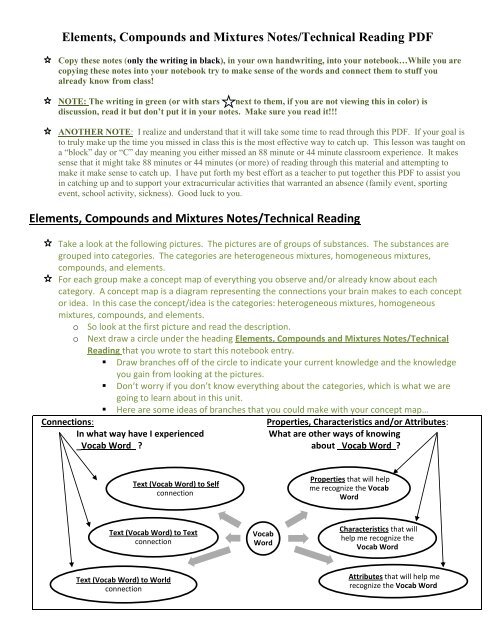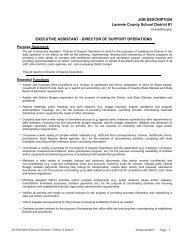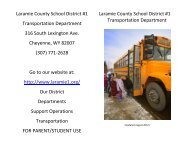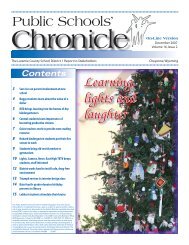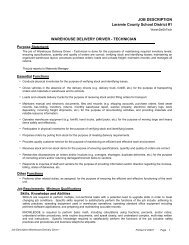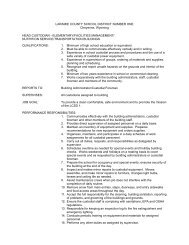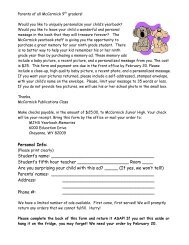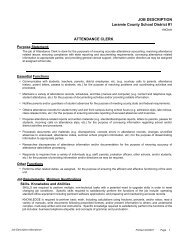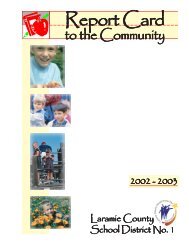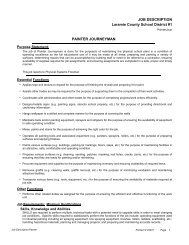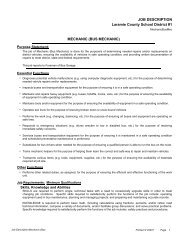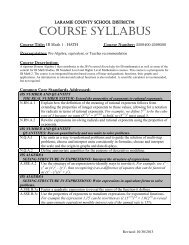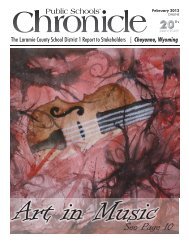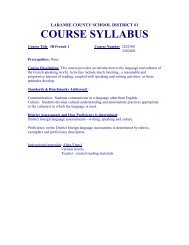Elements, Compounds and Mixtures Notes/Technical ... - 1(A,C)
Elements, Compounds and Mixtures Notes/Technical ... - 1(A,C)
Elements, Compounds and Mixtures Notes/Technical ... - 1(A,C)
You also want an ePaper? Increase the reach of your titles
YUMPU automatically turns print PDFs into web optimized ePapers that Google loves.
<strong>Elements</strong>, <strong>Compounds</strong> <strong>and</strong> <strong>Mixtures</strong> <strong>Notes</strong>/<strong>Technical</strong> Reading PDF<br />
Copy these notes (only the writing in black), in your own h<strong>and</strong>writing, into your notebook…While you are<br />
copying these notes into your notebook try to make sense of the words <strong>and</strong> connect them to stuff you<br />
already know from class!<br />
NOTE: The writing in green (or with stars next to them, if you are not viewing this in color) is<br />
discussion, read it but don’t put it in your notes. Make sure you read it!!!<br />
ANOTHER NOTE: I realize <strong>and</strong> underst<strong>and</strong> that it will take some time to read through this PDF. If your goal is<br />
to truly make up the time you missed in class this is the most effective way to catch up. This lesson was taught on<br />
a “block” day or “C” day meaning you either missed an 88 minute or 44 minute classroom experience. It makes<br />
sense that it might take 88 minutes or 44 minutes (or more) of reading through this material <strong>and</strong> attempting to<br />
make it make sense to catch up. I have put forth my best effort as a teacher to put together this PDF to assist you<br />
in catching up <strong>and</strong> to support your extracurricular activities that warranted an absence (family event, sporting<br />
event, school activity, sickness). Good luck to you.<br />
<strong>Elements</strong>, <strong>Compounds</strong> <strong>and</strong> <strong>Mixtures</strong> <strong>Notes</strong>/<strong>Technical</strong> Reading<br />
Take a look at the following pictures. The pictures are of groups of substances. The substances are<br />
grouped into categories. The categories are heterogeneous mixtures, homogeneous mixtures,<br />
compounds, <strong>and</strong> elements.<br />
For each group make a concept map of everything you observe <strong>and</strong>/or already know about each<br />
category. A concept map is a diagram representing the connections your brain makes to each concept<br />
or idea. In this case the concept/idea is the categories: heterogeneous mixtures, homogeneous<br />
mixtures, compounds, <strong>and</strong> elements.<br />
o So look at the first picture <strong>and</strong> read the description.<br />
o Next draw a circle under the heading <strong>Elements</strong>, <strong>Compounds</strong> <strong>and</strong> <strong>Mixtures</strong> <strong>Notes</strong>/<strong>Technical</strong><br />
Reading that you wrote to start this notebook entry.<br />
• Draw branches off of the circle to indicate your current knowledge <strong>and</strong> the knowledge<br />
you gain from looking at the pictures.<br />
• Don’t worry if you don’t know everything about the categories, which is what we are<br />
going to learn about in this unit.<br />
• Here are some ideas of branches that you could make with your concept map…<br />
Connections:<br />
In what way have I experienced<br />
_Vocab Word ?<br />
Properties, Characteristics <strong>and</strong>/or Attributes:<br />
What are other ways of knowing<br />
about Vocab Word ?<br />
Text (Vocab Word) to Self<br />
connection<br />
Properties that will help<br />
me recognize the Vocab<br />
Word<br />
Text (Vocab Word) to Text<br />
connection<br />
Vocab<br />
Word<br />
Characteristics that will<br />
help me recognize the<br />
Vocab Word<br />
Text (Vocab Word) to World<br />
connection<br />
Attributes that will help me<br />
recognize the Vocab Word
Take a look at the first picture of the examples of HETEROGENEOUS MIXTURES… <strong>and</strong> make a concept<br />
map detailing the common characteristics you see when observing all the samples of<br />
HETEROGENEOUS MIXTURES ….<br />
These are examples of heterogeneous mixtures<br />
Nerds, gobstopers, sugar, salt <strong>and</strong> sweet tarts<br />
mixture<br />
Rock salt, marbles, binder clips, bbs mixture<br />
Dice, dish soap, pennies, rubber stoppers<br />
mixture
Here’s an idea of how you could start your concept map…<br />
The mixtures look like all r<strong>and</strong>om<br />
stuff just put together.<br />
The different stuff in the heterogeneous mixture<br />
don't look like they are joined together in any<br />
special way.<br />
HETEROGENEOUS<br />
MIXTURES<br />
Now you draw some connection bubbles to the HETEROGENEOUS MIXTURES center bubble aim for at<br />
least 3 (so you only have one more to do for the HETEROGENEOUS MIXTURES category concept map).<br />
Now concept map the remaining categories: homogeneous mixtures, compounds, <strong>and</strong> elements.<br />
Aim for 3 connection bubbles for each map.<br />
The maps don’t necessarily have to connect to each other but if you find connections among the<br />
categories then make your connection apparent.
These are examples of homogeneous mixtures<br />
(solutions)…<br />
salt water<br />
sugar water<br />
Solution of Iron (III) Chloride (FeCl 3 )<br />
dissolved in water<br />
Solution of Magnesium Chloride (MgCl 2 )<br />
dissolved in water<br />
Brass cylinder (not to ring on top)(brass is a<br />
homogeneous mixture of copper (Cu) <strong>and</strong> Zinc<br />
(Zn)
These are examples of compounds<br />
Salt (NaCl)<br />
Sugar (C 6 H 12 O 6 )<br />
Copper (II) Sulfate (CuSO 4 )<br />
Water (H 2 O)
o These are examples of elements<br />
• Tin (Sn)<br />
• Aluminum (Al)<br />
• Zinc (Zn)<br />
• Oxygen (O 2 )<br />
• Hydrogen (H 2 )
Ok now that you have concept mapped the four categories now read section 2.1 of our<br />
new physical science book.<br />
Follow these simple instructions <strong>and</strong> use the access code to create an online account<br />
with the makers of the physical science book <strong>and</strong> use the online book to read section 2.1<br />
(this section is all about, you guessed it heterogeneous mixtures, homogeneous<br />
mixtures, compounds, <strong>and</strong> elements!)<br />
Class access code:<br />
CD10C96E1633D8460431<br />
As you read add any information you learn about heterogeneous mixtures,<br />
homogeneous mixtures, compounds, <strong>and</strong> elements to the concept maps that you have<br />
made. By adding what you learn as you read to the concept maps, the concept maps<br />
help to remember the information for you so you can use them as a reference as the<br />
unit moves forward.<br />
Congratulations you have done some work in order to make up the time you missed in<br />
class! Keep up the hard work!<br />
I look forward to seeing you in class!!! <br />
Please come in during AST ASAP <strong>and</strong> ask any clarifying questions you may have <br />
Note: I realize that the “Academic” in the academic support sign above is spelled incorrectly. This “Acadurmic Support” sign<br />
is on this fusion PDF to remind you to come to AST, <strong>and</strong> what better way than with a “catchy” sign? I in no way support the<br />
misspelling of words, but I do support the thoughtful student sentiment expressed when the students responsible for this<br />
sign gave it to me. Thanks Tayton, Ross, <strong>and</strong> Iggy!


